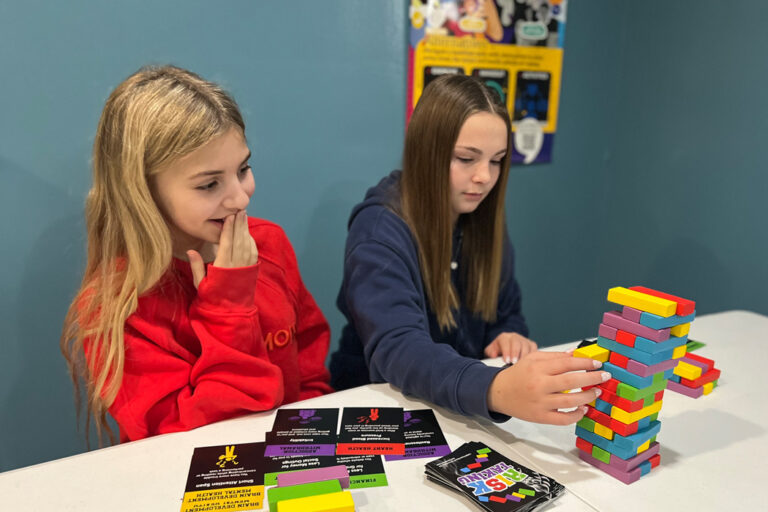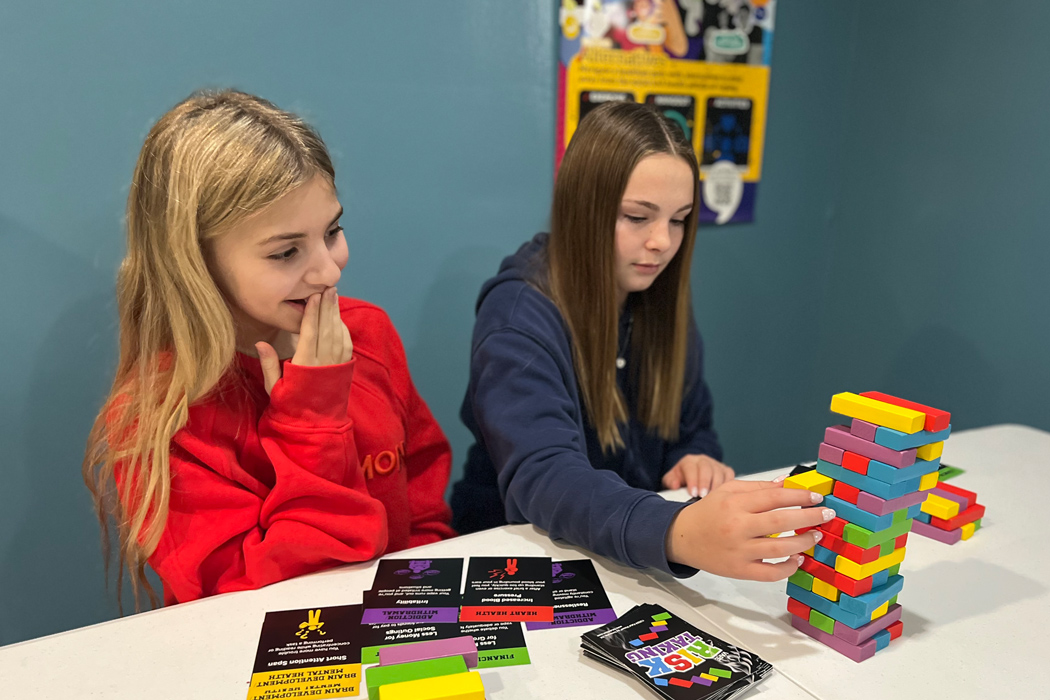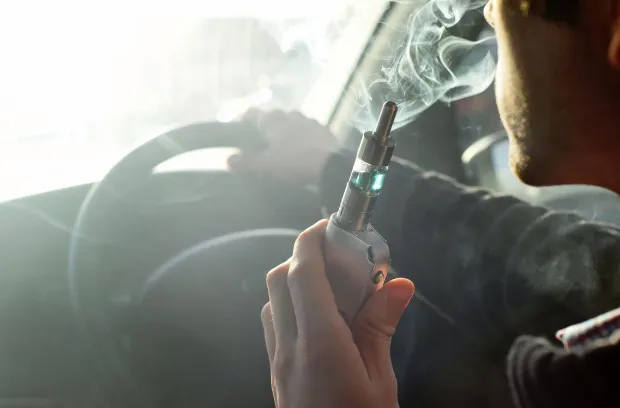
What’s Included in the Vaping Dangers Kit
In this blog, we’ll show you what’s included and give tips on how to use the Vaping Dangers Event Kit. The Vaping Dangers Kit is a great way to introduce
Be First to Know About Fatal Speeding™ — Launching Early 2026! LEARN MORE

It’s important to stay aware of current health risks, and talking about the dangers of vaping with students and teens is an important part of a health and educational program. Discussing the health risks of vaping can help them make healthier choices and understand the consequences of choosing to vape or use e-cigarettes. In this blog, we’ll cover some of the main topics you might consider adding to an educational course and suggest resources for hands-on learning opportunities to help solidify the message.
To start a discussion with students about the dangers of vaping, it’s important to start with the basics and teach them what vaping is so they can identify it and understand why it’s dangerous. Vape products, also called e-cigarettes, are a battery-operated device that delivers nicotine by inhaling the fumes produced from heat. These devices come in various forms, including vape pens, tank systems, mods, and popular pod-based systems like JUUL, as well as disposable e-cigarettes.
Consider discussing the history and evolution of vape products, how the devices work, and what harmful chemicals are contained in the liquid and emitted in the aerosol. The aerosol, often mistakenly called vapor, can contain ultrafine particles, heavy metals like nickel, tin, and lead, and volatile organic compounds. It also includes diacetyl, a flavoring chemical linked to serious lung disease, as well as formaldehyde and acrolein, which can cause irreversible lung damage. It may also be helpful to cover the key differences between traditional cigarette smoking and vaping, debunking common misconceptions that e-cigarette products are a safer alternative. Starting your educational course with the basics on what vaping is can allow for better comprehension and understanding for later learning opportunities.
When talking about the dangers of vaping with students, it’s key to share the health risks that are associated. Use credible sources, like the CDC, to share statistics and information on health risks, like cardiovascular issues and heart disease, lung issues and EVALI, nicotine addiction, brain development, and more. Talking about the chemicals in these products and their long-term effects is needed to share the dangers of these products. Learn more about the health risks associated with vaping in this blog and consider incorporating the Fatal Vision Vaping Dangers Program Kit, which offers engaging, hands-on learning about the health risks and dangers of vaping.
Students and teens may be at a greater risk to start vaping than any other age demographic. The appeal of e-cigarettes, combined with targeted marketing and social influences, has led to startlingly high numbers of teen vaping nationwide. Many students remain unaware of the potential health risks associated with e-cigarettes and nicotine addiction.
According to the 2024 National Youth Tobacco Survey, approximately 7.8% of high school students and 3.5% of middle school students reported current (past 30-day) use of e-cigarettes. This data highlights the pervasive nature of youth vaping and the urgent need for comprehensive education.
Talk with students about peer pressure, social media, and marketing tactics that may be used against them, and offer factual resources and information to help them make healthier, more informed choices. Learn more about the popularity and use of vaping among teens here.
Vape companies use marketing and advertising to try to gain new customers. However, many of their initiatives or campaigns may target students or young adults. Talk with your students and practice identifying campaigns aimed towards youth. It may be helpful to discuss how young people are targeted through flavor options, where vape companies are advertising, and celebrity endorsements.
Similar to cigarette smoke, vape products emit secondhand smoke, which may impact others around the user. Talk with your students about these effects on children, the chemicals released, diminished air quality, and how students can protect others around them. Use credible resources to share information and offer brainstorming time on how students can protect themselves and others.
One of the common misconceptions about vape or e-cigarette products is that they’re easy to quit or stop using. This is highly inaccurate; vape products contain nicotine, which is a highly addictive chemical. Talk with your students about the dangers of nicotine addiction, and share first-hand accounts and testimonials from other young adults who struggle to stop using vape products. Cover the symptoms of nicotine withdrawal, like irritability, anxiety, difficulty concentrating, cravings, headaches, and sleep disturbances, and prepare credible resources for students who may be trying to stop using nicotine-based products. Quitting may be very difficult due to the social routine and the addictive qualities of nicotine, but it is possible.
Talking with students and young adults about a variety of health topics is key to creating a safe place where they can learn and open up. Talk about the correlation between vaping and mental health, and discuss how using these products may increase the risk of poor mental health. Nicotine addiction can be a source of stress and may correlate with anxiety, depression, or other mental health emergencies. Provide students with ample resources to rely on if needed and help them learn about these correlations to ensure healthier life choices.
Wrap up your vaping educational course by sharing some of the laws that may be passed to regulate vaping products, chemicals, and advertising or marketing from these vaping companies. Share how individuals and organizations in communities can help lead the charge for reform and give resources that may be present in your community to help stop the spread of vaping products and offer resources for those looking to quit. Consider hanging banners and posters around schools, community centers, and public spaces to spread the word. Host events using the hands-on Dangers of Vaping Program Kit to help youth and parents understand the dangers of vaping.
Teaching your community about the dangers of vaping is key to encouraging healthy choices and preventing vaping-related health issues, especially in teens and young adults. Use engaging learning tools, facts and statistics, videos, and posters to keep the message fresh in their minds. Reach out to our team of experts to get started on a vaping education program.
Innocorp is the pioneering developer of Fatal Vision® Goggles and other experiential learning tools designed to educate on the dangers of impairment and promote risk prevention. Innocorp provides impactful, hands-on resources used globally by law enforcement, educators, and safety professionals to demonstrate the consequences of substance use, risky driving, and other dangerous behaviors.
We’d love to online chat! We are available Monday-Friday from 8am-5pm (CST):
Or schedule a time for a consultation:

In this blog, we’ll show you what’s included and give tips on how to use the Vaping Dangers Event Kit. The Vaping Dangers Kit is a great way to introduce

Use accredited resources and hands-on learning opportunities to help teens and students understand how to fight the vaping epidemic. Helping your community, students, and parents understand the dangers of

Teaching young adults about the health risks of vaping can help prevent vaping-related lung issues and nicotine addictions. As health risks arise, educators and teachers face new topics to